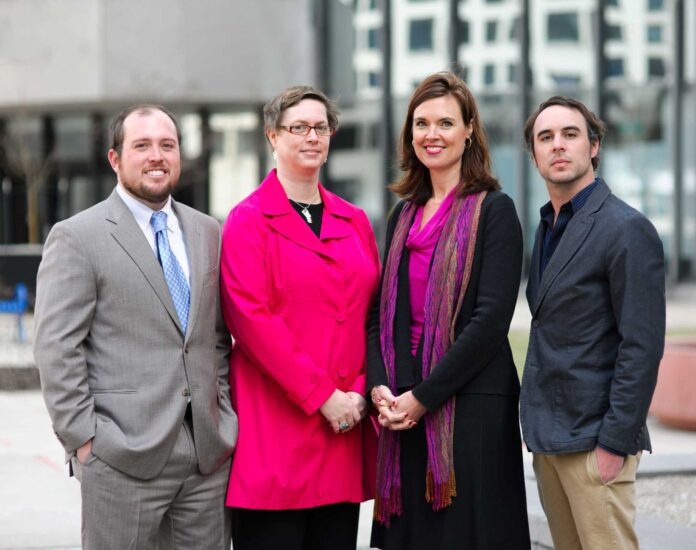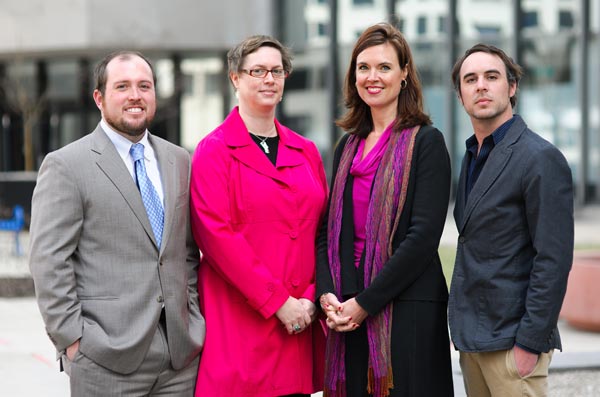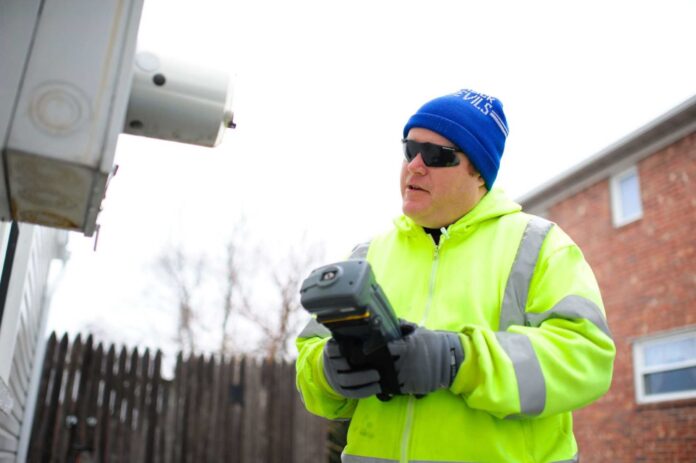They are four unique people, but they symbolize the initiative, creativity and success that characterizes countless people in the Toledo area.
The businessman, artist, mom/careerwoman and sports fan all make the most of the Glass City.
The first four subjects of the revived Toledo Free Press Brain Gain series have a lot to say about life around Lake Erie, and represent the reasons many of us call the region home.
John Smythe
When John Smythe took over Habitec Security, an electronic security company, he was 23 years old. Smythe’s father Jim called the University of Dayton graduate home in October 2005. Jim had started the company in 1972, not too long after college himself. Shortly after his son’s return, Jim died of leukemia and the company became John’s.
“It’s a scenario where you gotta buckle down and learn the business quick for the employees and the family,” Smythe said of taking the reins as president. His mother serves as CEO.
Growing up, Smythe, who graduated from St. Francis de Sales High School, didn’t think about whether he’d go into the family business.
“I imagine it was in my dad’s big dreams, but we didn’t really talk about it,” Smythe, now 29, said.
Smythe was able to win over employees, advisers and customers alike despite his young age.
“Obviously, the employees were glad we were continuing the business, but there’s that uneasiness,” he said.
Now the business is picking up as the economy improves; the company also went into medical alert alarms about two years ago.
The company president sees youth as a positive and thinks it could help Toledo grow even more.
“We need young people moving to Toledo to keep this going. Young people bring energy and creative ideas,” he said, referring to the boom of new businesses in Downtown.
A network of colleagues has also helped Smythe succeed in Toledo, something he attributes to the region’s friendliness.
“If you put yourself out there, people want to get to know you and you end up creating a big network of people in Toledo,” he said. “Toledo allows you to be somebody and make a difference and I think it may be more difficult to do that in a larger city.”
Smythe makes a difference through his work with the Boys & Girls Club of Toledo and the Toledo Leukemia & Lymphoma Society, where he served as chair last year. Serving Toledo was also important to Smythe’s father.
“His last words to us, and this sounds out of a movie or something, was, ퟀ�?Help people,’” Smythe said.
Besides charity, Smythe enjoys Toledo’s proximity to several waterways.
“I’m really an enthusiast for bodies of water. The Maumee River’s a fantastic asset as well as Lake Erie; there can be so much fun to be had on both bodies of water, fishing, skiing, whatever you like,” he said.
Smythe also likes going to Mud Hens and Walleye games.
“I absolutely love that we have these minor league teams that provide great entertainment, but at the same time, it’s in and out. You don’t need to be in an hour traffic jam and pay $40 to park,” he said.
But what really makes Smythe love Toledo is the people.
“People really care about one another; there’s a community feeling,” he said of the city. “I’m the biggest fan of Toledo. If anyone needs help to recruit someone, you bring them over to me and I’ll be talking to them for a while and I’ll get them sold on Toledo pretty quick.”
Sarah Miller
Artist and teacher Sarah Miller has traveled the world, but she calls Toledo home.
Miller, 44, grew up in Perrysburg, although her family moved to Arizona in 1978. Still, she spent summers in the area. “I’ve always maintained my roots here. I really feel that this is home,” she said.
At age 12, the multimedia artist had her first exhibit and even had an interested buyer. But Miller hung onto the piece instead of letting it go.
“I thought to myself, if [the customer] wanted to buy it, it must be pretty good; so I still have it,” she chuckled.
Since her debut, Miller’s pieces have been displayed across the country, including the National Gallery of Art Library in Washington, D.C.
Since 2005, when Miller went “digital,” much of her work has been centered around photography. One of the comments she frequently gets on her photos is that they look like paintings.
“I’m a painter at heart and that comes across in my photography,” she said.
Miller attended Rollins College in Florida for her undergraduate degree and Bowling Green State University for her graduate work. The artist lived in San Francisco, Santa Fe, N.M., and Washington, D.C.., after her schooling. During college, she had spent time studying in Europe.
In 2003, Miller began teaching art history and studio art at Owens Community College. In 2006, she left that job to pursue three teaching offers at the University of Michigan, Adrian College and Siena Heights University.
Soon however, Miller made an even more radical change and moved to San Juan, Puerto Rico, on sabbatical for two years.
“I liked [San Juan] because it was a combination of my three favorite places: the Caribbean, Spain and New Orleans. As an artist it really appealed to me, the colors, the architecture, the light,” Miller said of the city where she did several series of artwork.
Despite her love of San Juan, Miller returned to the Toledo area in September 2011.
“The world feels so unsettled and home is a very nice place to be,” she said. She joined the part-time faculty at the University of Toledo and considers teaching her greatest contribution to the area.
“The vast majority of my students seem to thrive in my classes,” she said. “If I can help another human being find a passion, that’s the most significant thing I can teach.”
While she was away, Miller missed what many others do about their hometown: food.
“The thing I really love about Toledo is our signature restaurants,” she said, naming Byblos in Toledo and Baidu in Perrysburg.
Additionally, there’s plenty to do for a single, working Toledoan, she said.
“It’s also what you make of it in terms of if you’re single and professional; what is important to you, who are the people you’re circulating with and what are you choosing to do with your free time? I think there’s plenty of things to do here with your free time,” she said, adding that she recently went to her first Walleye game.
“It comes down to quality of life, what’s it like to go to the grocery store,” Miller said simply.
Miller has established roots in the area. Her great-great-great-grandfather was Richard Peters who settled Petersburg, Mich., and her great-great-aunt was a Toledo concert manager and artist.
“She brought the best of the world in the arts to Toledo — the London symphony, the Russian ballerinas to the amphitheater at the zoo — so the arts are kinda in my family,” Miller said.
Nathan Steinmetz
Toledo is a sports fan’s dream come true, said Nathan Steinmetz, online marketing manager for the Mud Hens and Walleye.
“Toledo is an absolute gem for the sports fan when you think about it,” the Tiffin native said. “If you’re a sports fan, and I am, I can’t think of a better place to live, even how we sit right in between Ohio State and Michigan, arguably the biggest sports rivalry in the country.”
Steinmetz, 31, grew up loving sports and his father had season tickets for the Cleveland Indians.
“I was a big fan of the games and the teams, but going there as much as we did, we probably went to 15, 20 games a year, I really found myself becoming interested in how the team was run,” he said.
He attended Bowling Green State University, graduating with a marketing degree in 2003. During college, he ran marketing for the school’s recycling program before landing an internship with the Toledo Mud Hens during the winter of his senior year. Steinmetz stayed on after graduation to learn the ropes during baseball season.
A month after the internship ended, a sales position opened up and Steinmetz was selected. After working in that position for about five years, it was determined the Mud Hens needed an online marketing manager.
“I was the one who had done most of it, so it just became logical that I would continue to do more of it and then the hockey team became a real thing and it was realized that someone actually needed to have that position,” Steinmetz said. He has become an industry leader in terms of the number of fans and followers the teams’ pages have.
Despite a busy schedule, Steinmetz finds time to help out his hometown and orchestrates the social media for the Seneca County Museum and Heritage Festival.
“Both my parents are really involved in that sort of thing in Tiffin, so it’s nice to be able to help them out and use some of the things I’ve learned to promote their organizations,” he said.
Steinmetz, who bought his first home a year and a half ago, values his proximity to his family.
“I kinda get all the big-city things in Toledo, but I’m only an hour drive away from my family, which is great,” he said.
Although he’s moved out of Downtown, Steinmetz praised Toledo’s growing nightlife.
“It’s been neat to see how the nightlife Downtown has started to blossom,” he said. “Just to walk by Table Forty4, The Blarney and Pizza Papalis, and to see the people out on the patios, to see people in line waiting to get in, it’s something that just a few years ago, we didn’t have.”
Part of what brings the crowds to Toledo is the facilities for sports and concerts, he added. Attendance at Mud Hens games is still as high as it was 11 years ago when the team moved Downtown; Steinmetz attributed this to the phenomenon known as Toledo pride.
“There’s a lot of pride in this town. People are proud to be from here. They care about the community, they care about how other people view this community, and they support things when given the opportunity,” he said.
Megan Coyle-Stamos
Megan Coyle-Stamos’ love for Toledo is deep. The funeral director and prearrangement specialist’s family has owned and operated the Coyle Funeral Home for 125 years and Coyle-Stamos doesn’t see herself breaking that tradition.
“I wouldn’t want to live anywhere else, not in a million years,” she said. Despite her passion for her job and hometown, Coyle-Stamos, 40, had planned a different path originally.
The Bowsher High School graduate attended Indiana University in Bloomington for degrees in business management and fashion design. She landed a full-time job in Cincinnati with Parisian department stores after college. For the next several years, she lived in cities like Detroit and Indianapolis, opening new stores for the chain.
Eventually, Coyle-Stamos was ready for a change.
“I decided that industry was not for me. There was no fulfillment in it. It was not challenging for me,” she said.
Coyle-Stamos came home to Toledo one day to work on her resume. She found herself in a conversation with the woman who at that time held the prearrangement specialist position at Coyle Funeral Home. The woman pointed out that the job fit all the criteria on Coyle-Stamos’ list for job qualities.
Shortly after, Coyle-Stamos began doing prearrangement services for several family-owned funeral homes in Detroit before getting a job training other specialists through marketing firm Trust 100.
But another change was in store for Coyle-Stamos. About 11 years ago, she became pregnant with her first child and was ready to move back home. She joined the family business and never looked back. She has now been married for 15 years and has an 11-year-old daughter and 8-year-old son.
“I’ve got a great boss (father, Joseph Coyle). If my kids are sick, I don’t come into work,” she said with a laugh. “[The staff] supports each other because we all have little kids or medium-sized kids. And that’s really key to quality of life — career satisfaction, but also flexibility.”
One of things she loves about Toledo is all the family-friendly activities it provides, listing the Toledo Zoo, Toledo Museum of Art, Metroparks of Toledo Area and Imagination Station.
The pace of life and cost of living also appeal to Coyle-Stamos.
“One of the reasons I chose to live here is the pace of Toledo. It’s very comfortable; it’s not go, go, go, go,” she said, adding, “You can live comfortably here and you don’t have to make half a million dollars to own a home and to be able to go out for dinner once in a while.”
She gives back to the city she loves through her charity work. Coyle-Stamos is active in several organizations, including the advisory board for the Swan Creek Retirement Community. She also is in charge of the Cell Phones for Soldiers drive at Coyle Funeral Home, which has collected 1,500 phones. Each donated phone is sent to ReCellular Inc. for recycling, creating $5 that usually covers a 60-minute calling card.
Coyle-Stamos is also passionate about local foods and community-supported agriculture, in which customers can buy a share of land that farmers grow crops on and bring the food to the Toledo Farmers Market for pickup.
“It’s the whole idea of staying local and buying local, keeping the earth sustainable; just making these little kinds of choices and helping others understand they can make these little choices and if everybody makes the same little, local choices, then the whole community benefits,” she said.
The work she does at her job also gives her a sense of belonging to the community. “It’s a very deep and intimate service to others and to have true heartfelt thanks and appreciation and respect and hugs for a very much appreciated job well done, I really feel that’s very emotionally satisfying and fulfilling,” Coyle-Stamos said.




























